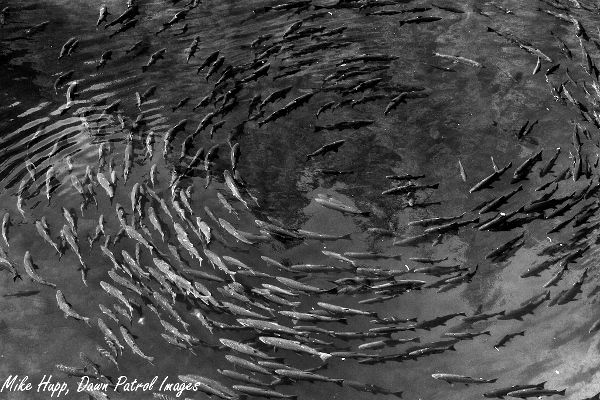Few anglers fish the Scott River -- and those that do generally don't talk about it publicly -- but this Klamath River tributary winds through ag country in rural Siskiyou County and supports healthy salmon and steelhead runs -- when there's water.
Right now, a sizable number
ESA-listed Chinook salmon are holding at the Shasta's mouth, waiting for enough water to flow so they can swim upstream and spawn.
Will that water ever appear?
 They circle. They wait. Will the water ever come? (Image courtesy Mike Hupp, Dawn Patrol Images)
They circle. They wait. Will the water ever come? (Image courtesy Mike Hupp, Dawn Patrol Images)
Or will crowded conditions and low, warm flows lead to the rapid spread of disease -- and perhaps even a fishkill?
While the salmon circle endlessly, the Karuk and Yurok tribes wonder why the U.S. Forest Service isn't exercising a their legal water right to protect the salmon:
The Forest Service’s water right for the month of August is 30 cubic feet per second (cfs). Their right is 40 cfs in October to accommodate adult migration. Currently the river is running at 18 cfs, which is simply not enough water for migrating salmon to make it up river to reproduce.
Despite the fact that the number of days per year that the USFS water right is not met has increased steadily since the 1980 adjudication, the agency has never lodged a complaint with California Water Resources Control Board. Before the adjudication, it was rare for flows to ever drop below 30 cubic feet per second (cfs). In fact between 1942 and 1980, the Scott dropped below 30 cfs on average only 5.6 days a year, mostly in drought years. Between 1980 and 2009, the flows dipped below 30 cfs on average 35 days a year. This year, the river has been below 30 cfs since August 3rd!
Agricultural water users contend the river simply doesn't flow much in the fall, but historical data (see last paragraph above) suggests flows are decreasing, and that it's likely something else is at work.
Water diversions for ag are often mentioned, and as local water activist Felice Pace has pointed out, increased pumping of groundwater seems tied to decreasing flows in the Scott.
Whatever the cause for the decline -- and unless there simply isn't any water being diverted -- it's clear the US Forest Service should make their legally allowed water call to protect the ESA listed salmon.
See you swimming in circles, Tom Chandler.